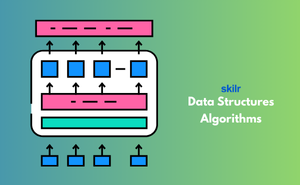👇 CELEBRATE CLOUD SECURITY DAY 👇
00
HOURS
00
MINUTES
00
SECONDS

About Data Structures Algorithms
A specified place that may be used to store and arrange data is called a data structure. Additionally, an algorithm is a series of procedures used to solve a certain issue. We may create computer programs that are effective and optimized by learning data structures and algorithms.
Why is Data Structures Algorithms important?
Algorithms and data structures rank among the most crucial components in computer science. We can organize and store data using data structures, and process it meaningfully using algorithms.
Who should take the Data Structures Algorithms Exam?
Data Structures Algorithms Certification Course Outline
Industry-endorsed certificates to strengthen your career profile.
Start learning immediately with digital materials, no delays.
Practice until you’re fully confident, at no additional charge.
Study anytime, anywhere, on laptop, tablet, or smartphone.
Courses and practice exams developed by qualified professionals.
Support available round the clock whenever you need help.
Easy-to-follow content with practice exams and assessments.
Join a global community of professionals advancing their skills.
The exam is designed to assess a candidate’s ability to efficiently implement and apply core data structures and algorithms to solve computational problems, with a focus on optimizing performance and understanding complexity analysis.
The exam typically includes multiple-choice questions, coding exercises, and theoretical questions. It may also contain algorithmic problem-solving tasks that require implementation and performance analysis.
The exam covers a broad range of topics including arrays, linked lists, stacks, queues, trees, graphs, sorting and searching algorithms, dynamic programming, recursion, and time-space complexity analysis.
Yes, candidates should have experience with at least one programming language, such as Python, Java, or C++, as the exam includes coding challenges and implementation tasks.
The exam is designed to be challenging, typically aimed at intermediate to advanced candidates with foundational programming knowledge and a good understanding of algorithmic principles.
The exam duration usually ranges between 60 minutes, depending on the certification body and exam format.
Most exams allow candidates to use widely supported programming languages like Python, Java, C++, and JavaScript. It’s important to verify the specific language requirements before taking the exam.
Upon passing the exam, candidates receive a certification that demonstrates their proficiency in data structures and algorithms, which can be used to enhance resumes, portfolios, and career opportunities in software development and engineering.
Exam policies vary by provider, but some exams do incorporate negative marking, especially for multiple-choice sections, to discourage guessing and ensure accuracy in responses.